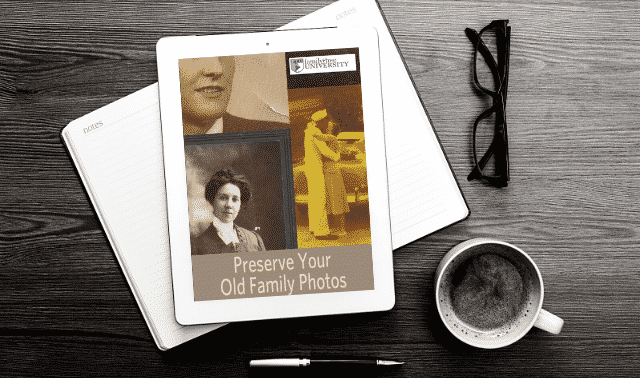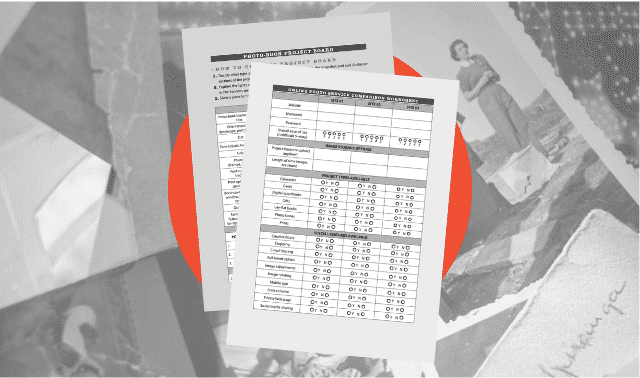Sign up for the Family Tree Newsletter! Plus, you’ll receive our 10 Essential Genealogy Research Forms PDF as a special thank you.
Get Your Free Genealogy Forms
"*" indicates required fields
How Photos Can Transform Your Genealogy Research
Tricks for Identifying Ancestors in Photos
Digital Photo Tools, Techniques and Resources
Resources for Finding Old Photos
Valuable Photography Preservation Tools and Resources
You may never know for certain how your great-great grandmother felt on her wedding day or what a scorching day filled with hard work and rough play looked like for your distant cousins. Fortunately, old photos can offer a glimpse into the past, capturing singular moments (both the mundane and the monumental) that will endure in black and white for years to come.
But after you discover those old photos in a box and dust them off, you may have several questions: Who’s in the photos? When and where were they taken? How can I ensure that my family can enjoy these photos for years to come?
In this guide, we address some common questions and concerns genealogists have surrounding old photos. We also highlight some of our most valuable resources, tools and guides to ensure that you have everything you need to preserve these treasured snapshots of the past.
How Photos Can Transform Your Genealogy Research
Photos Can Put a Face to Your Ancestors
You may spend hours at a time poring over your family tree and as a result become well-acquainted with your ancestors’ names, birthplaces and other pertinent information. But in many cases, you may have never been able to put faces to those special names. Thus, finding photos of ancestors you’ve never seen before can feel like striking gold—you get see the person behind the legacy.
Photos Can Help You Create a Timeline of Your Ancestors’ Lives
We can often glean key information about our ancestors from Census records, obituaries and other documents—birth dates and death dates, for example. But what about all of the remarkable events that happened in between? What did the world look like when your ancestors were children, teenagers, adults? Just one photo of a great-great grandparent with a wild hairstyle or a certain model of car can help you piece together their life, decade by decade.
Photos can also help contextualize specific points in your ancestors’ lives. For example, Photo Detective Maureen Taylor was able to determine when a photo might have been taken simply by zeroing in on certain clues present on a 19th-century cabinet card.
Photos Allow You to Preserve Memories
An extravagant wedding, a fun-filled birthday party, even just an ordinary Sunday evening—When we capture these moments on camera, they live forever. By keeping old photos and integrating them into genealogy projects, you can honor your ancestors and the times in their lives in which they felt most content and accomplished.
Important Photography Terms
Before delving too deeply into specific research techniques and preservation tools, it might help to review some common photography terms you may stumble across. Below we cover a range of different terms, from types of photos to technical preservation terms.
Types of Photos
Ambrotype –A type of photo placed on glass and backed with a dark background to give the appearance of a positive photo. The ambrotype was patented in 1854. You can learn more about it in our article comparing ambrotypes to other popular photo types.
Carte des Visite – A small card photograph no larger than 9 cm by 6 cm.
Crayon Portrait/Charcoal Portrait – A photo that is artistically enhanced with the help of charcoal, ink or pastels. You can learn more these portraits in this article written by Maureen Taylor.
Daguerreotype – A reflective, silver-coated photo placed on a copper plate
Photo Negative – A photograph in which the areas intended to be dark are light and the areas intended to be light are dark
Post-Mortem Photography – An art form in which a person is photographed after they have died. The subject may be on their deathbed or posed aesthetically to convey an air of peace, restfulness and comfort
Tintype – A non-reflective photo placed on a sheet of iron. It was patented in 1856.
Photo Preservation Terms and Tools
Acid Free Card Stock – A Protective cover that protects photos and other sensitive materials from the elements and excessive handling
Archival Box – A preservation storage container designed specifically to protect materials sensitive to damage from handling, the elements and age (for example, old photos, documents, etc.)
EXIF (Exchangeable Image File) – Data captured by your camera, phone or scanner that includes camera settings, date, location and file information (size and type)
Flatbed Scanner – A scanner with a flat surface that allows for the effortless scanning of documents, photos and other valuable materials
Photo Resolution – A measure of the level of detail that a photo contains
PTC (International Press Telecommunications Council) Data – Information included by the camera user, such as captions and keywords
Metadata – Data that provide crucial information about other data
Tricks for Identifying Ancestors in Photos
As already mentioned above, photos can reveal a great deal about your ancestors—even those about whom you may know very little. Even if you don’t have any dates to work with, photos can provide needed context to help you create a plausible timeline Maureen Taylor laid down three specific tips for identifying unfamiliar people in photos.
Below are some other tips and strategies you may use if you are examining photos filled with fresh faces:
- Compare Faces Across Many Different Photos. If you stumble upon an unfamiliar face while studying old family photos, don’t shrug it off. Set it aside and carefully scan other photos either for that same person or for people with similar features. Pay special attention to group photos, which allow you to compare faces quickly without having to flip back and forth between photos.
- Study the Clothing. You don’t have to be a fashion expert to tell that some styles define specific decades—sometimes before fizzling out entirely. With that in mind, don’t ignore what a photo subject is wearing. Anything from a flowing wedding dress to a gaudy hat can tell you a lot.
- Always Scan the Backdrop. Of course, you want to look beyond your ancestors’ smiling faces and unmatched style for clues—that is, what’s going on in the background. For example, a well-worn Bible or proudly displayed cross may signify someone very devout in their faith.
- Look for a Signature. If you have observed old photographs carefully in the past, you probably noticed that many were signed in some way. It wasn’t uncommon for photographers to attach their names to their work in this way—which means an extra research clue for you! Don’t overlook this clue if you’re trying to identify an ancestor. You can look up the photographer to see where they might have done business. If the signature appears to be in another language, you may want to try translations as well.
Photo Preservation Tips
Your old photos have stood the test of time so far. Some might look as though they had just been taken yesterday, the subject bright-eyed and smiling big. Others might be in decent condition—they could just use a little bit of care after being stowed away for so long. How you attend to old photos will depend upon a couple of factors. For example, if they have suffered some damage, you will want to mend those issues without worsening the problem. Here are some tips and resources to ensure that photos stay safe:
- Do Not Store Your Photos in Humid Places. Old photos are very sensitive to extreme temperatures. Make sure that you are storing your photos someplace where the temperature remains consistently stable, neither too hot nor too cold. This is especially true for photo negatives.
- Do Not Attempt to Remove Photos Stuck to Glass over Heat (or Other DIY Methods). While it may be tempting to try out neat, cheap and quick preservation tricks to free your photo from glass, you might end up causing further damage. There are safer ways to handle this dilemma.
- Do Not Discount Damaged Photos Altogether. In many cases, you can still salvage them with the right tools and proper care. If the damage is very severe and risks becoming worse, you can scan the photo or take a picture of it to ensure that you have preserved somewhere.
If you happen to come across an entire photo album, you can ensure that you can treasure that heirloom now and for years to come by practicing careful preservation techniques and precautions. This means that you should:
- Remove old photos with a micro spatula
- Store the album somewhere safe from the elements—neither hot nor too cold
- Ensure that your hands are completely clean. Consider wearing gloves just to be extra safe.
Photo Preservation Projects
You have gathered several photos that you never want to lose to clutter or time—but simply tossing them all into a box doesn’t seem to do them the justice they deserve. The good news is that there are many creative ways to preserve your most cherished family photos. For example, you could print a calendar, design a keepsake ornament or even create a necklace that you can wear anywhere.
There is also always the classic photo book. With a photo book, you get to choose how to tell your ancestors’ life story through photos (depending, of course, on the photos at your disposal). You might create a photo book that spans their entire life—from birth to death—or focus just on a specific period of time. Whatever you choose, you can rest easy knowing that those photos will forever tell their story from the security of a beautifully crafted book.
Digital Photo Tools, Techniques and Resources
Thanks to technology, your most cherished family photos don’t have to live only in tattered old albums and on cluttered desks. You can immortalize them with just a click of a button or two. That said, such technology can seem intimidating if it’s new to you. Fortunately, there are many handy resources to help you find the tools you need to digitally save your photos so that you can access them whenever you desire. Here, we break them down into two distinct categories: Organizing and Editing.
1. Organizing
You may wonder: “What is the best tool for photo preservation?” The answer to this question will depend upon your personal needs—how many photos you wish to save, the condition of said photos and your plans for preservation (whether that’s creating a beautiful photo book or just adopting a safe place to keep your photos where pests and humidity can’t get to them).
If you don’t have any specific goals laid out yet, you can always start by organizing what you do have. There are many tech tools that can help you with this. Such tools not only allow you to keep your photos in a safe place, they can also free up some of your workspace. After all, too much paper can be difficult to manage.
But even after you land on the right photo preservation tool for your needs, you will want to adopt a strategy for managing all of your photos so that you can find them when you need them without having to comb countless files. While not genealogist’s strategy may look the same, you might benefit from considering this acronym as you devise your own: LOCKSS.
LOCKSS stands for:
L – Lots
O – Of
C – Copies
K – Keep
S – Stuff
S – Safe
In other words? Never count on holding tight to just the original copy of any given photo; take many and keep them in places to which you will have frequent and easy access.
2. Editing
Technology allows you to do more than just keep your old photos safe in digital vaults; it also gives the opportunity to enhance even the blurriest, worn photos and bring them to life in new remarkable ways. Digital editing allows you to do the following:
- Enhance and correct colors that have been distorted with time
- Edit out tears, bends and water damage
- Boost faded images
- Colorize black and white photos
To sum it all up, technology allows you to keep your photos safe for years to come, refine your photos to be more expressive and colorful than ever and so much more.
Resources for Finding Old Photos
Not everyone is lucky enough to chance upon boxes and boxes filled with old photos. Thanks to the internet, your search for snapshots of your ancestors does not have to begin and end with dusty storage spaces. You can browse almost two dozen different online historical photo databases. If you’re after family photos in particular, the “big” genealogy websites like Ancestry, MyHeritage and FamilySearch boast robust databases. You can also explore a number of smaller, independently-run websites. Who knows what discoveries await you?
Valuable Photography Preservation Tools and Resources
Library of Congress Digital Collections
Society of American Archivists
Related Reads
A version of this article was posted online in February 2024. Last updated: July 2025









